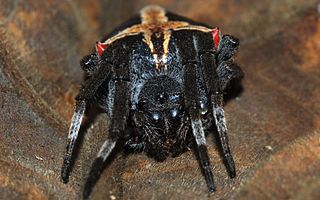
Uloboridae is a family of nonvenomous spiders, known as cribellate orb weavers or hackled orb weavers. Their lack of venom glands is a secondarily evolved trait. Instead, they wrap their prey thoroughly in silk, cover it in regurgitated digestive enzymes, and then ingest the liquified body.

Aculepeira is a genus of orb-weaver spiders first described by R. V. Chamberlin & Wilton Ivie in 1942.

Micrathena is a genus of orb-weaver spiders first described by Carl Jakob Sundevall in 1833. It contains more than a hundred species, most of them Neotropical woodland orb-weavers. The name is derived from the Greek "micro", meaning "small", and the goddess Athena. It includes over a hundred species, including four in the United States and Canada. Among these four species, female spined micrathena have five pairs of conical tubercles, female M. mitrata have two short posterior pairs, and female arrow-shaped micrathena have three pairs. Species with extremely long spines evolved at least eight times in the genus Micrathena and likely function as anti-predator defenses. The only species recorded from Canada is M. sagittata, found in Ontario.
Bertrana is a genus of Central and South American orb-weaver spiders first described by Eugen von Keyserling in 1884. It includes some of the smallest known araneid orb-weavers. Bertrana striolata females are 4.5 mm long or less. The eight eyes are in two rows. The abdomen is white on top and on the sides, with multiple hieroglyphic-like lines and bars of many different shapes and length. In females, these are red, in males, black.
Kaira, sometimes called frilled orbweavers, is a mostly neotropical genus of orb-weaver spiders first described by O. Pickard-Cambridge in 1889. It includes sixteen described species that occur from South America up to the southern and eastern USA. It is presumably related to Aculepeira, Amazonepeira and Metepeira.

Acacesia is a genus of orb-weaver spiders first described by Eugène Simon in 1895. It contains six species with a mostly neotropical distribution, ranging from South America to Mexico. One species, A. hamata, is found in the US as well.
Testudinaria is a genus of orb-weaver spiders first described by Władysław Taczanowski in 1879.

Parawixia is a genus of orb-weaver spiders first described by F. O. Pickard-Cambridge in 1904. Most species are found in the Neotropics but one species, Parawixia dehaani, is found in Australasia and tropical Asia as far west as India.
Amazonepeira is a genus of South American orb-weaver spiders first described by Herbert Walter Levi in 1989.
Enacrosoma is a genus of orb-weaver spiders first described by Cândido Firmino de Mello-Leitão in 1932.
Hingstepeira is a genus of South American orb-weaver spiders first described by Herbert Walter Levi in 1995.
Hypognatha is a genus of orb-weaver spiders first described by F. E. Guérin-Méneville in 1839.
Kapogea is a genus of orb-weaver spiders first described by Herbert Walter Levi in 1997.

Mecynogea is a genus of orb-weaver spiders first described by Eugène Simon in 1903. The name is derived from the Greek mekyno (μηυνω), meaning "to lengthen", and "gea" (γεα), meaning "earth".
Metazygia is a genus of orb-weaver spiders first described by F. O. Pickard-Cambridge in 1904. They physically resemble members of Nuctenea, but they do not have fine setae on the carapace.
Micrepeira is a genus of orb-weaver spiders first described by E. Schenkel in 1953.
Ocrepeira is a genus of orb-weaver spiders first described by George Marx in 1883.
Tatepeira is a genus of Central and South American orb-weaver spiders first described by Herbert Walter Levi in 1995.
Wagneriana is a genus of orb-weaver spiders first described by F. O. Pickard-Cambridge in 1904.
Xylethrus is a genus of Central and South American orb-weaver spiders first described by Eugène Simon in 1895.






